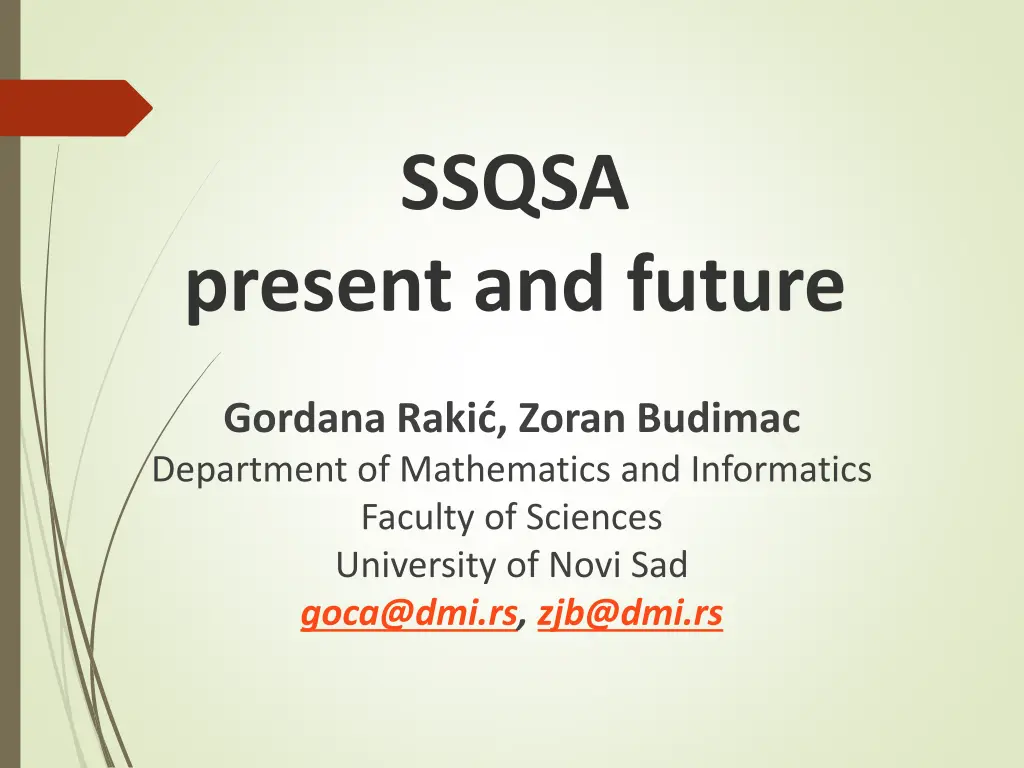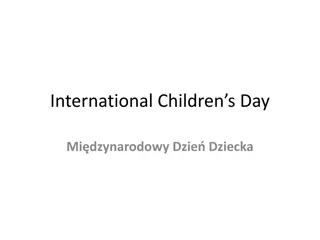
SSQSA Overview: Software Quality Static Analyzers Framework
Explore the SSQSA framework developed by Gordana Rakić and Zoran Budimac from the Department of Mathematics and Informatics at the University of Novi Sad. Learn about the mission, objectives, applicability in research and education, and the architecture of SSQSA for enhancing software quality.
Download Presentation

Please find below an Image/Link to download the presentation.
The content on the website is provided AS IS for your information and personal use only. It may not be sold, licensed, or shared on other websites without obtaining consent from the author. If you encounter any issues during the download, it is possible that the publisher has removed the file from their server.
You are allowed to download the files provided on this website for personal or commercial use, subject to the condition that they are used lawfully. All files are the property of their respective owners.
The content on the website is provided AS IS for your information and personal use only. It may not be sold, licensed, or shared on other websites without obtaining consent from the author.
E N D
Presentation Transcript
SSQSA present and future Gordana Raki , Zoran Budimac Department of Mathematics and Informatics Faculty of Sciences University of Novi Sad goca@dmi.rs, zjb@dmi.rs
Outline SSQSA mission Brief description of SSQSA framework Applicability of SSQSA SSQSA in research and education Conclusion
SSQSA Set of Software Quality Static Analyzers Objectives Overall: consistency of software quality analysis when applied to the source code written in different computer languages In particular to provide set of static software analyzers to ensure, check and consequently increase the quality of modern software products Two important features of the framework: Adaptability of the framework to different input languages Extensibility of the available set of analysis with new analysis algorithms as needed based on its main characteristic language independency based on eCST (enriched Concrete Syntax Tree) representation of source code
Outline SSQSA mission Brief description of SSQSA framework Applicability of SSQSA SSQSA in research and education Conclusion
SSQSA architecture LEVEL I: SSQSA front-end eCST Generator source code set of eCSTs eCSTs created by parsers generated by ANTLR LEVEL II: Generators of derived internal representations eGDN Generator eCFG Generator LEVEL III: SSQSA eCST manipulators eCST Antigenerator eCST Adaptor 6 6
SSQSA architecture LEVEL IV: SSQSA back-ends (SSQSA tools) Static analysis tools that use eCST representation SNAIPL software network analyzer SSCA software structure change analyzer SMIILE software metrics calculator LICCA for code clones LEVEL V: Integration of SSQSA tools with other tools Tools that use outputs of SSQSA tools Testovid Metrics repository 7 7
Adaptability to a new language Translate the language specification to grammar in ANTLR notation (write the ANTLR grammar) Add a rule for syntax tree generation to the grammar (rewrite the rules), Add the universal nodes to the syntax tree (extend the rules), Generate the parser and the scanner Add language to the XML configuration file for supporting languages 9
Extendibility to a new analysis Define the set of universal nodes needed to implement wanted algorithm, If necessary add the new nodes To catalog To existing ANTLR grammar as it is described before (for all languages), If grammar has been modified generate the scanner and the parser (for all languages), Traverse the eCST Use the incorporated universal nodes to accomplish the analysis. 10
Outline SSQSA mission Brief description of SSQSA framework Applicability of SSQSA SSQSA in research and education Conclusion
Applicability of SSQSA Three interconnected area of application: In industry Quality monitoring and control in real-life software projects In science Improvement of features of SSQSA framework In education By involving students in development of SSQSA components Consequently students are learning specific concepts by practical work By involving SSQSA in assessment of students solutions
Outline SSQSA mission Brief description of SSQSA framework Applicability of SSQSA SSQSA in research and education Conclusion
Intermediate representations, graph and tree structures (usage and manipulation), etc. Computer languages, programming techniques and paradigms, compiler construction, etc. Software quality and static analysis (algorithms, implementations, tools, standards, etc) Alternative architectural and design solutions, reengineering, refactoring, testing, validation, advanced application, etc. XML technologies, alternative storage solutions, etc. 14
SSQSA in research and education Subjects: ATSE, student project, seminar paper X (x depends on semester) theses, etc. Until 2014 More that 30 successful students Bachelor, master and doctoral Novi Sad, Maribor, Budapest and Skoplje More than 15 research papers
SSQSA in research and education ATSE 2014/2015 ATSE: Advanced Topics in Software Engineering Static Timing Analysis (Timing Analysis on Code Level) Goal: to implement and integrate estimation of WCET: Worst Case Execution Time Team work 1 PhD student 3 Master students
SSQSA in research and education ATSE 2014/2015 WCET is estimated based on possible execution paths eCFG manipulation was required
SSQSA in research and education ADP 2014/2015 ADP: Architecture, Design and Patterns SSQSA as a case study PART 1: Architecture Propose an architecture for software quality monitoring and assurance portal ! students still do not know real SSQSA architecture !! some differences are made between real SSQSA and required portal PART 2: Refactoring Refactor a SSQSA component (previously developed by other students and full of bad smells) PART 3: Design Patterns Propose usage of design patterns in specific SSQSA functionality (component) ! students have access to an implementation without design patterns
SSQSA in research and education ADP 2014/2015 ADP: Architecture, Design and Patterns Professor: Vladimir Kurbalija Students 49 active students 46 passed practical part (invited for an oral exam) 30 passed whole exam older than 3rd year of studies (usually 4th) Master (and sometimes bachelor)
Outline SSQSA mission Brief description of SSQSA framework Applicability of SSQSA SSQSA in research and education Conclusion
Conclusion SSQSA is suitable platform for multiple application in research and education Good environment for team work and simulation of real-life project situations So far introduced in education through several subjects on all levels of study Implemented collaboration between students on different levels of study Still there are many unexploited possibilities
SSQSA present and future THANK YOU Gordana Raki , Zoran Budimac Department of Mathematics and Informatics Faculty of Sciences University of Novi Sad goca@dmi.rs, zjb@dmi.rs






















